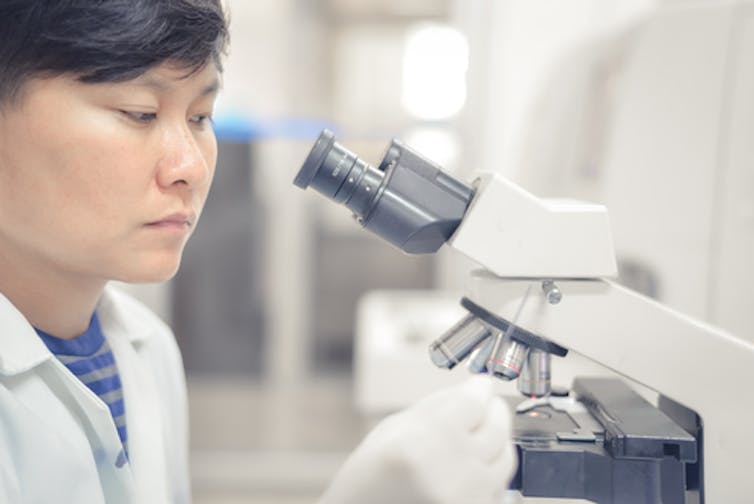Ted Turner has Lewy body dementia, but what is that?
- Written by Melissa J. Armstrong, Assistant Professor, Neurology, University of Florida
Ted Turner recently announced[1] that he has Lewy body dementia, a diagnosis that the late comic and actor Robin Williams[2] was given after his death.
The disease is frequently unrecognized even by doctors, despite the fact that Lewy body dementia is the second most common dementia[3].
In one study, almost 70 percent of people diagnosed with Lewy body dementia saw three consultants[4] before receiving the diagnosis. For a third of people with the disease, getting the correct diagnosis took more than two years[5].
October is Lewy Body Dementia Awareness Month. As a physician specializing in Lewy body dementia, I often hear patients and families describe delays in getting a diagnosis. It doesn’t have to be this way. Awareness is critical, particularly as new opportunities emerge for diagnosis and treatment.
What is Lewy body dementia?
The word “dementia” describes a condition affecting a person’s memory and thinking that is a decline from how he or she used to function and that is severe enough to affect day-to-day life. Alzheimer’s disease dementia and Lewy body dementia are the two most common types[6].
Lewy body dementia gets its name from the abnormal protein clumps that are seen on autopsies of the brains of people with Lewy body dementia. The protein alpha-synuclein[7] clumps into spheres that can be seen using a microscope. These are called Lewy bodies because they are named after the scientist who first described them, F. H. Lewy[8].
Lewy body dementia is an umbrella term that includes two different conditions: dementia with Lewy bodies and Parkinson’s disease dementia.
 Robin Williams was diagnosed with diffuse Lewy body disease only after his death in 2014.
Kathy Hutchins/Shutterstock.com[9]
Robin Williams was diagnosed with diffuse Lewy body disease only after his death in 2014.
Kathy Hutchins/Shutterstock.com[9]
In dementia with Lewy bodies, a person develops memory and thinking problems before or at the same time as he or she develops movement problems that resemble Parkinson’s disease.
In Parkinson’s disease dementia, a person who has experienced Parkinson’s disease movement problems for years then also develops trouble with memory and thinking.
These two conditions share many of the same features[10]. In addition to memory and thinking problems and movement problems, people with these conditions can have fluctuations in their alertness and concentration, hallucinations and paranoia, acting out dreams during sleep, something called REM sleep behavior disorder[11], low blood pressure with standing, depression and daytime sleepiness, among other symptoms.
Correct diagnosis essential
Getting the correct diagnosis is critical for patients and families. While no one wants to hear that they have a disease that currently can’t be cured, patients and families often feel relief[12] that they finally have an explanation for what’s happening.
The diagnosis of Lewy body dementia is often missed, however, due to lack of awareness[13] by physicians, patients and families. Even for people eventually receiving a diagnosis of Lewy body dementia, research shows their first diagnosis is commonly incorrect[14]. In that study, 26 percent of people later diagnosed with Lewy body dementia were first diagnosed with Alzheimer’s disease, and 24 percent were given a psychiatric diagnosis like depression.
Knowing the correct diagnosis lets patients and families connect to resources such as the Lewy Body Dementia Association[15], an organization dedicated to helping people living with this disease. The organization provides education on Lewy body dementia, helps patients and families know what to expect, links patients and families to support and resources and connects them to research opportunities[16].
Once a diagnosis is made, physicians can also suggest potentially helpful treatments[17]. Medications can include carbidopa/levodopa, a drug that helps with slow movements, and drugs called cholinesterase inhibitors, which were developed for Alzheimer’s disease[18] but may also help people with Lewy body dementia[19].
Avenues for research
There is a great deal that we still need to learn about the Lewy body dementias. Increasing research is a priority of the National Institutes of Health[20].
In 2017, experts published new criteria for the diagnosis of dementia with Lewy bodies[21], aiming to improve accurate diagnosis. In 2018, the Lewy Body Dementia Association identified 24 Research Centers of Excellence[22] to create a network of centers working to better understand and treat the disease.
There are also currently multiple research studies trying to find drugs to help people with Lewy body dementias, including studies to investigate drugs hoped to improve thinking in dementia with Lewy bodies[23] and Parkinson’s disease dementia[24].
 Researchers into Lewy body dementia hope that continued studies will lead to improved treatments.
toeytoey/Shutterstock.com[25]
Researchers into Lewy body dementia hope that continued studies will lead to improved treatments.
toeytoey/Shutterstock.com[25]
Scientists also hope to learn more about the alpha-synuclein protein clumps in the Lewy body diseases. Recent vaccine studies[26] suggested that the human body might be able to create antibodies against alpha-synuclein. This could be the first step toward a vaccine. If effective, a vaccine would prompt the immune system of people with these diseases to create antibodies to attack and clear the protein clumps[27].
With advances in diagnosis and treatment, there is reason for hope.
Editor’s Note: This is an updated version of an article[28] originally published Oct. 5, 2017.
References
- ^ Ted Turner recently announced (www.npr.org)
- ^ Robin Williams (www.scientificamerican.com)
- ^ second most common dementia (www.lbda.org)
- ^ saw three consultants (www.ncbi.nlm.nih.gov)
- ^ getting the correct diagnosis took more than two years (www.ncbi.nlm.nih.gov)
- ^ two most common types (www.lbda.org)
- ^ alpha-synuclein (www.michaeljfox.org)
- ^ F. H. Lewy (www.ncbi.nlm.nih.gov)
- ^ Kathy Hutchins/Shutterstock.com (www.shutterstock.com)
- ^ share many of the same features (www.lbda.org)
- ^ REM sleep behavior disorder (www.mayoclinic.org)
- ^ patients and families often feel relief (alzres.biomedcentral.com)
- ^ lack of awareness (www.ncbi.nlm.nih.gov)
- ^ first diagnosis is commonly incorrect (www.ncbi.nlm.nih.gov)
- ^ Lewy Body Dementia Association (www.lbda.org)
- ^ research opportunities (www.lbda.org)
- ^ suggest potentially helpful treatments (www.mayoclinic.org)
- ^ developed for Alzheimer’s disease (www.alz.org)
- ^ help people with Lewy body dementia (www.ncbi.nlm.nih.gov)
- ^ priority of the National Institutes of Health (www.ninds.nih.gov)
- ^ new criteria for the diagnosis of dementia with Lewy bodies (www.ncbi.nlm.nih.gov)
- ^ Research Centers of Excellence (www.lbda.org)
- ^ hoped to improve thinking in dementia with Lewy bodies (clinicaltrials.gov)
- ^ Parkinson’s disease dementia (clinicaltrials.gov)
- ^ toeytoey/Shutterstock.com (www.shutterstock.com)
- ^ vaccine studies (www.michaeljfox.org)
- ^ attack and clear the protein clumps (parkinson.org)
- ^ article (theconversation.com)
Authors: Melissa J. Armstrong, Assistant Professor, Neurology, University of Florida
Read more http://theconversation.com/ted-turner-has-lewy-body-dementia-but-what-is-that-104291

